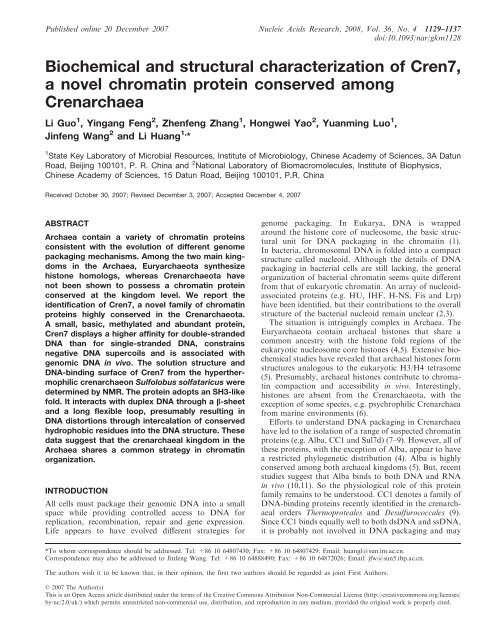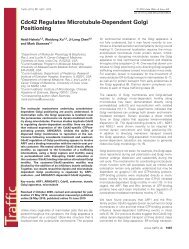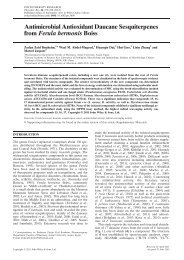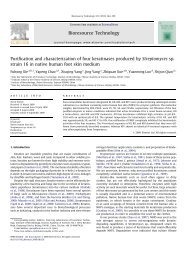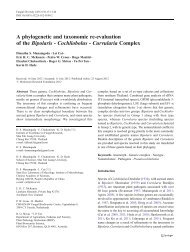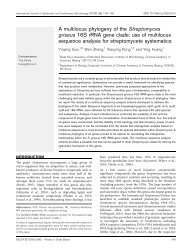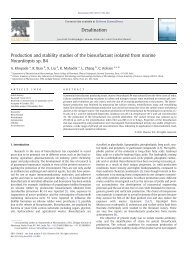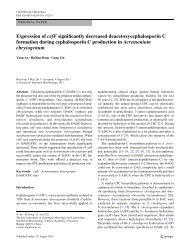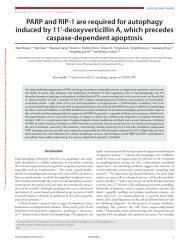Biochemical and structural characterization of Cren7, a novel ...
Biochemical and structural characterization of Cren7, a novel ...
Biochemical and structural characterization of Cren7, a novel ...
Create successful ePaper yourself
Turn your PDF publications into a flip-book with our unique Google optimized e-Paper software.
Published online 20 December 2007 Nucleic Acids Research, 2008, Vol. 36, No. 4 1129–1137<br />
doi:10.1093/nar/gkm1128<br />
<strong>Biochemical</strong> <strong>and</strong> <strong>structural</strong> <strong>characterization</strong> <strong>of</strong> <strong>Cren7</strong>,<br />
a <strong>novel</strong> chromatin protein conserved among<br />
Crenarchaea<br />
Li Guo 1 , Yingang Feng 2 , Zhenfeng Zhang 1 , Hongwei Yao 2 , Yuanming Luo 1 ,<br />
Jinfeng Wang 2 <strong>and</strong> Li Huang 1, *<br />
1 State Key Laboratory <strong>of</strong> Microbial Resources, Institute <strong>of</strong> Microbiology, Chinese Academy <strong>of</strong> Sciences, 3A Datun<br />
Road, Beijing 100101, P. R. China <strong>and</strong> 2 National Laboratory <strong>of</strong> Biomacromolecules, Institute <strong>of</strong> Biophysics,<br />
Chinese Academy <strong>of</strong> Sciences, 15 Datun Road, Beijing 100101, P.R. China<br />
Received October 30, 2007; Revised December 3, 2007; Accepted December 4, 2007<br />
ABSTRACT<br />
Archaea contain a variety <strong>of</strong> chromatin proteins<br />
consistent with the evolution <strong>of</strong> different genome<br />
packaging mechanisms. Among the two main kingdoms<br />
in the Archaea, Euryarchaeota synthesize<br />
histone homologs, whereas Crenarchaeota have<br />
not been shown to possess a chromatin protein<br />
conserved at the kingdom level. We report the<br />
identification <strong>of</strong> <strong>Cren7</strong>, a <strong>novel</strong> family <strong>of</strong> chromatin<br />
proteins highly conserved in the Crenarchaeota.<br />
A small, basic, methylated <strong>and</strong> abundant protein,<br />
<strong>Cren7</strong> displays a higher affinity for double-str<strong>and</strong>ed<br />
DNA than for single-str<strong>and</strong>ed DNA, constrains<br />
negative DNA supercoils <strong>and</strong> is associated with<br />
genomic DNA in vivo. The solution structure <strong>and</strong><br />
DNA-binding surface <strong>of</strong> <strong>Cren7</strong> from the hyperthermophilic<br />
crenarchaeon Sulfolobus solfataricus were<br />
determined by NMR. The protein adopts an SH3-like<br />
fold. It interacts with duplex DNA through a b-sheet<br />
<strong>and</strong> a long flexible loop, presumably resulting in<br />
DNA distortions through intercalation <strong>of</strong> conserved<br />
hydrophobic residues into the DNA structure. These<br />
data suggest that the crenarchaeal kingdom in the<br />
Archaea shares a common strategy in chromatin<br />
organization.<br />
INTRODUCTION<br />
All cells must package their genomic DNA into a small<br />
space while providing controlled access to DNA for<br />
replication, recombination, repair <strong>and</strong> gene expression.<br />
Life appears to have evolved different strategies for<br />
genome packaging. In Eukarya, DNA is wrapped<br />
around the histone core <strong>of</strong> nucleosome, the basic <strong>structural</strong><br />
unit for DNA packaging in the chromatin (1).<br />
In bacteria, chromosomal DNA is folded into a compact<br />
structure called nucleoid. Although the details <strong>of</strong> DNA<br />
packaging in bacterial cells are still lacking, the general<br />
organization <strong>of</strong> bacterial chromatin seems quite different<br />
from that <strong>of</strong> eukaryotic chromatin. An array <strong>of</strong> nucleoidassociated<br />
proteins (e.g. HU, IHF, H-NS, Fis <strong>and</strong> Lrp)<br />
have been identified, but their contributions to the overall<br />
structure <strong>of</strong> the bacterial nucleoid remain unclear (2,3).<br />
The situation is intriguingly complex in Archaea. The<br />
Euryarchaeota contain archaeal histones that share a<br />
common ancestry with the histone fold regions <strong>of</strong> the<br />
eukaryotic nucleosome core histones (4,5). Extensive biochemical<br />
studies have revealed that archaeal histones form<br />
structures analogous to the eukaryotic H3/H4 tetrasome<br />
(5). Presumably, archaeal histones contribute to chromatin<br />
compaction <strong>and</strong> accessibility in vivo. Interestingly,<br />
histones are absent from the Crenarchaeota, with the<br />
exception <strong>of</strong> some species, e.g. psychrophilic Crenarchaea<br />
from marine environments (6).<br />
Efforts to underst<strong>and</strong> DNA packaging in Crenarchaea<br />
have led to the isolation <strong>of</strong> a range <strong>of</strong> suspected chromatin<br />
proteins (e.g. Alba, CC1 <strong>and</strong> Sul7d) (7–9). However, all <strong>of</strong><br />
these proteins, with the exception <strong>of</strong> Alba, appear to have<br />
a restricted phylogenetic distribution (4). Alba is highly<br />
conserved among both archaeal kingdoms (5). But, recent<br />
studies suggest that Alba binds to both DNA <strong>and</strong> RNA<br />
in vivo (10,11). So the physiological role <strong>of</strong> this protein<br />
family remains to be understood. CC1 denotes a family <strong>of</strong><br />
DNA-binding proteins recently identified in the crenarchaeal<br />
orders Thermoproteales <strong>and</strong> Desulfurococcales (9).<br />
Since CC1 binds equally well to both dsDNA <strong>and</strong> ssDNA,<br />
it is probably not involved in DNA packaging <strong>and</strong> may<br />
*To whom correspondence should be addressed. Tel: +86 10 64807430; Fax: +86 10 64807429; Email: huangl@sun.im.ac.cn.<br />
Correspondence may also be addressed to Jinfeng Wang. Tel: +86 10 64888490; Fax: +86 10 64872026; Email: jfw@sun5.ibp.ac.cn.<br />
The authors wish it to be known that, in their opinion, the first two authors should be regarded as joint First Authors.<br />
ß 2007 The Author(s)<br />
This is an Open Access article distributed under the terms <strong>of</strong> the Creative Commons Attribution Non-Commercial License (http://creativecommons.org/licenses/<br />
by-nc/2.0/uk/) which permits unrestricted non-commercial use, distribution, <strong>and</strong> reproduction in any medium, provided the original work is properly cited.
1130 Nucleic Acids Research, 2008, Vol. 36, No. 4<br />
instead play a role in the protection <strong>of</strong> ssDNA in these<br />
organisms, which lack a canonical ssDNA-binding protein<br />
(SSB) (9). Sul7d is restricted to the order Sulfolobales.<br />
It includes a family <strong>of</strong> small, basic <strong>and</strong> abundant proteins<br />
that bind much more strongly to dsDNA than to ssDNA<br />
in vitro <strong>and</strong> are associated with the genomic DNA in vivo<br />
(11–13). These properties, together with the ability <strong>of</strong> the<br />
protein to constrain DNA supercoils <strong>and</strong> compact DNA,<br />
are consistent with a role for Sul7d in genome packaging.<br />
So far, no chromatin proteins have been found that<br />
are conserved among all phylogenetic branches <strong>of</strong><br />
Crenarchaea. Whether Crenarchaea employ a conserved<br />
mechanism in chromatin organization is unknown. An<br />
answer to this question will not only shed light on the<br />
evolution <strong>of</strong> chromatin organization but also increase our<br />
knowledge about regulation <strong>of</strong> gene expression in<br />
Crenarchaea.<br />
In the present study, we report the identification <strong>of</strong> a<br />
family <strong>of</strong> small <strong>and</strong> basic DNA-binding proteins, denoted<br />
<strong>Cren7</strong>, that are highly conserved in Crenarchaea. <strong>Biochemical</strong><br />
<strong>and</strong> <strong>structural</strong> analyses show that <strong>Cren7</strong> is a<br />
chromatin protein. Our results suggest that the majority <strong>of</strong><br />
Crenarchaea share a common strategy in chromatin<br />
organization.<br />
MATERIALS AND METHODS<br />
Preparation <strong>of</strong> native <strong>and</strong> recombinant <strong>Cren7</strong> proteins<br />
Native <strong>Cren7</strong> was purified from Sulfolobus shibatae using<br />
the purification protocol described previously for Ssh10b<br />
(14) with modifications. Recombinant <strong>Cren7</strong> was prepared<br />
by amplifying the gene encoding the protein (SSO6901)<br />
from Sulfolobus solfataricus by PCR, cloning it into<br />
pET30a. The recombinant protein was subsequently overproduced<br />
in Escherichia coli strain Rosetta 2 (DE3) plysS<br />
<strong>and</strong> purified. Detailed purification procedures for native<br />
<strong>and</strong> recombinant <strong>Cren7</strong> proteins are in Supplementary<br />
Data.<br />
Protein identification<br />
Identification <strong>of</strong> <strong>Cren7</strong> was carried out by subjecting the<br />
purified protein to SDS–PAGE. The protein was digested<br />
in-gel with trypsin, <strong>and</strong> tryptic fragments were analyzed<br />
by LC-MS, as described (15).<br />
Quantitative immunoblotting<br />
Samples were taken from a growing S. solfataricus culture<br />
at various cell densities <strong>and</strong> centrifuged. Intracellular<br />
levels <strong>of</strong> <strong>Cren7</strong> were measured by immunoblotting using<br />
anti-<strong>Cren7</strong> antibodies, as described (11). Anti-<strong>Cren7</strong> antibodies<br />
were raised in rabbit using purified recombinant<br />
<strong>Cren7</strong>.<br />
Electrophoretic mobility shift assays (EMSA)<br />
Radiolabeling <strong>of</strong> DNA fragments <strong>and</strong> EMSAs were performed<br />
as described previously (11). A 60 bp dsDNA fragment<br />
(5 0 -GATCCCCCAATGCTTCGTTTCGTATCA<br />
CACACCCCAAAGCCTTCTGCTTTGAATGCTGCC)<br />
<strong>and</strong> a 60 nt ssDNA fragment [poly(GACT) 15 ] were used in<br />
this study.<br />
Thermal denaturation <strong>of</strong> dsDNA<br />
Recombinant <strong>Cren7</strong> was mixed with dsDNA (poly[dAdT]–<br />
poly[dAdT]) in 10 mM potassium phosphate (pH 7.0).<br />
Thermal denaturation <strong>of</strong> the DNA was measured at A 260<br />
in a temperature range from 258C to908C on a DU800<br />
UV/Visible spectrophotometer (Beckman). The melting<br />
temperature (T m ) was obtained using DU800 s<strong>of</strong>tware.<br />
Association <strong>of</strong> <strong>Cren7</strong> with nucleic acids in vivo<br />
The nature <strong>of</strong> nucleic acids bound by <strong>Cren7</strong> in the cell<br />
was determined by chromatin fractionation <strong>and</strong> by in vivo<br />
UV-crosslinking followed by co-immunoprecipitation,<br />
as described previously (10,11).<br />
Nick closure assays<br />
Plasmid pBR322 containing a single nick per circular<br />
molecule was prepared by digestion with the nicking<br />
enzyme Nb.Bpu10I (Fermentas). The nicked plasmid<br />
(0.5 mg) was mixed with recombinant <strong>Cren7</strong> in 20 mM<br />
Tris–Cl (pH7.5), 1 mM DTT <strong>and</strong> 100 mg/ml BSA <strong>and</strong><br />
ligated with T4 DNA ligase (Fermentas) for 5 min at 258C<br />
in a final volume <strong>of</strong> 15 ml. Samples were deproteinized <strong>and</strong><br />
analyzed by agarose gel electrophoresis in the presence or<br />
absence <strong>of</strong> chroloquine, as described previously (16).<br />
NMR spectroscopy<br />
<strong>Cren7</strong> were uniformly labeled with 15 N/ 13 C by growing<br />
the recombinant strain in M9-minimal medium containing<br />
15 NH 4 Cl <strong>and</strong> 13 C-glucose as the sole nitrogen <strong>and</strong> carbon<br />
sources, respectively. The labeled proteins were purified<br />
as described above. Samples for NMR measurements<br />
contained 1.0–2.0 mM <strong>Cren7</strong>, 90% H 2 O/10% D 2 O <strong>and</strong><br />
0.01% sodium 2,2-dimethylsilapentane-5-sulfonate (DSS)<br />
in 50-mM potassium phosphate buffer (pH 6.0).<br />
All NMR experiments were carried out at 310 K on a<br />
Bruker DMX 600 MHz spectrometer with a triple resonance<br />
cryo-probe. NMR experiments for 1 H, 15 N, <strong>and</strong> 13 C<br />
resonance assignments included: 2D 1 H- 1 H TOCSY,<br />
1 H- 1 H NOESY,<br />
1 H- 1 H DQF-COSY,<br />
1 H- 15 N HSQC,<br />
1 H- 13 C HSQC, 3D HNCACB, CBCA(CO)NH, HNCO,<br />
HN(CA)CO, HBHA(CBCA)CONH,<br />
1 H- 15 N TOCSY-<br />
HSQC, (H)CCH-TOCSY <strong>and</strong> HC(C)H-COSY. Four<br />
NOE experiments: 2D 1 H- 1 H NOESY, 3D 1 H- 15 N<br />
NOESY-HSQC <strong>and</strong> 1 H- 13 C NOESY-HSQC for aliphatic<br />
<strong>and</strong> aromatic regions with mixing times <strong>of</strong> 200 ms were<br />
carried out to obtain the distance constraints. Dihedral<br />
constraints were generated using TALOS (17). All NMR<br />
spectra were processed <strong>and</strong> analyzed using Felix s<strong>of</strong>tware<br />
(Accelrys Inc.). Proton chemical shifts <strong>and</strong> 15 N <strong>and</strong> 13 C<br />
chemical shifts were referenced to internal DSS <strong>and</strong><br />
indirectly to DSS, respectively (18).<br />
Initial structures <strong>of</strong> <strong>Cren7</strong> were generated using<br />
CANDID module <strong>of</strong> CYANA s<strong>of</strong>tware (19). The NOE<br />
assignments given by CANDID were checked manually<br />
<strong>and</strong> the structures were refined in explicit water using CNS<br />
s<strong>of</strong>tware (20) <strong>and</strong> RECOORDScript (21). 100 structures
Nucleic Acids Research, 2008, Vol. 36, No. 4 1131<br />
Figure 1. Identification <strong>of</strong> the <strong>Cren7</strong> protein family in Crenarchaea. (A) Purification <strong>of</strong> the S. shibatae <strong>Cren7</strong> protein. Lane 1, cell lysate; lane 2,<br />
ammonium sulfate fraction; lane 3, SP Sepharose peak fractions; lane 4, Resource S peak fractions; lane 5, heparin peak fractions; lane 6, flowthrough<br />
fractions from anti-Ssh7 antibody affinity column; lane 7, recombinant Sso<strong>Cren7</strong>; lane 8, native Ssh10b; lane 9, native Ssh7; M, molecular<br />
weight st<strong>and</strong>ards with molecular weights indicated. (B) Sequence alignment <strong>of</strong> <strong>Cren7</strong> homologs in Crenarchaea. Sequences are from Sulfolobus<br />
shibatae (Ssh<strong>Cren7</strong>), Sulfolobus solfataricus P2 (SSO6901), Sulfolobus tokodaii str.7 (ST_3948), Sulfolobus acidocaldarius DSM 639 (Saci_1307),<br />
Metallosphaera sedula DSM5348 (Msed_1762), Aeropyrum pernix K1(APE_0450a), Staphylothermus marinus F1 (Smar_0237), Hyperthermus butylicus<br />
DSM5456 (Hbut_0878 <strong>and</strong> Hbut_1128), Ignicoccus hospitalis KIN4/I(Igni_0039), Pyrobaculum isl<strong>and</strong>icum DSM4184 (Pisl_1589), Pyrobaculum<br />
aerophilum str. IM2 (PAE1516), Pyrobaculum arsenaticum DSM13514 (Pars_0631) <strong>and</strong> Pyrobaculum calidifontis JCM 11548 (Pcal_0878).<br />
(C) MALDI-TOF MS spectrum <strong>of</strong> native <strong>Cren7</strong> from S. shibatae. A cluster <strong>of</strong> peaks with a mass difference <strong>of</strong> 14 kDa between adjacent peaks<br />
are shown.<br />
were calculated, <strong>and</strong> 20 structures with lowest energies<br />
were selected for final analysis. The quality <strong>of</strong> the<br />
structures was analyzed with MOLMOL (22) <strong>and</strong><br />
PROCHECK-NMR (23). Structure figures were prepared<br />
using MOLMOL. Structural similarity was searched using<br />
Dali server (24) <strong>and</strong> SSM server (25).<br />
Binding <strong>of</strong> <strong>Cren7</strong> to a DNA duplex (5 0 -GCGAATT<br />
CGC) in 50-mM potassium phosphate buffer (pH 6.0) was<br />
monitored by 1 H- 15 N HSQC using the 15 N-labeled protein<br />
(0.2 mM). The backbone assignments <strong>of</strong> the <strong>Cren7</strong>–<br />
dsDNA complex were obtained in CBCA(CO)NH <strong>and</strong><br />
HNCA experiments, in which 15 N/ 13 C-labeled <strong>Cren7</strong><br />
(0.2 mM) was mixed with a slight excess amount <strong>of</strong><br />
dsDNA.<br />
Data deposition<br />
Chemical shift assignments <strong>of</strong> S. solfataricus <strong>Cren7</strong> have<br />
been deposited in the BioMagResBank under an accession<br />
number 15415. The atomic coordinates <strong>of</strong> S. solfataricus<br />
<strong>Cren7</strong> <strong>and</strong> all restraints have been deposited in the Protein<br />
Data Bank with accession code 2JTM.<br />
RESULTS<br />
Identification <strong>of</strong> <strong>Cren7</strong><br />
In the process <strong>of</strong> purifying Ssh7, a member <strong>of</strong> the Sul7d<br />
family from S. shibatae, we co-purified a small, abundant<br />
protein (Figure 1A). LC-MS analysis identified this protein<br />
as a homolog <strong>of</strong> the product <strong>of</strong> an unknown gene<br />
(SSO6901) in the S. solfataricus P2 genome. Sequence<br />
comparison shows that this <strong>novel</strong> protein is highly conserved<br />
among the crenarchaeotal lineage <strong>of</strong> the Archaea<br />
(Figure 1B). All genome-sequenced Crenarchaea except for<br />
Therm<strong>of</strong>ilum pendens Hrk5 <strong>and</strong> Cenarchaeum symbiosum<br />
encode a homolog <strong>of</strong> this protein. It is present in the orders<br />
Sulfolobales, Thermoproteales <strong>and</strong> Desulfurococcales. Since<br />
it was later shown to be a chromatin protein, we designate<br />
this <strong>novel</strong> protein family as <strong>Cren7</strong> following the nomenclature<br />
used for Sul7d.<br />
Sulfolobus shibatae <strong>Cren7</strong> contains 60 amino acid<br />
residues (theoretical M r : 6637) <strong>and</strong> is highly basic (calculated<br />
pI: 9.87). The protein has 22 charged residues including<br />
12 lysines <strong>and</strong> 2 arginines. N-terminal microsequencing<br />
revealed the lack <strong>of</strong> the initiator methionine in the protein.<br />
The native protein appeared to be methylated at multiple<br />
sites since a cluster <strong>of</strong> peaks differing by 14 kDa between<br />
adjacent peaks were detected by MALDI-TOF-TOF in the<br />
protein sample (Figure 1C). Mass fingerprinting showed<br />
that the protein was methylated at these sites to various<br />
extents (Supplementary Figures S1 <strong>and</strong> S2 <strong>and</strong> Supplementary<br />
Table S1). <strong>Cren7</strong> exists as a monomer in solution<br />
<strong>and</strong> is stable at high temperature (Supplementary Data,<br />
Supplementary Figure S3).<br />
<strong>Cren7</strong> is a chromatin protein<br />
We first investigated the interaction <strong>of</strong> <strong>Cren7</strong> with DNA<br />
by EMSA. <strong>Cren7</strong>–DNA complexes initially generated
1132 Nucleic Acids Research, 2008, Vol. 36, No. 4<br />
Figure 2. Interaction <strong>of</strong> <strong>Cren7</strong> with DNA in vitro. (A) Comparison <strong>of</strong> binding <strong>of</strong> <strong>Cren7</strong> to dsDNA <strong>and</strong> ssDNA. Recombinant <strong>Cren7</strong> was incubated<br />
with a radiolabeled 60 bp dsDNA or 60 nt ssDNA. Protein–DNA complexes were subjected to electrophoresis in polyacrylamide. Protein<br />
concentrations were 0, 0.02, 0.04, 0.08, 0.16, 0.31, 0.63, 1.3, 2.5, 5 <strong>and</strong> 10 mM, respectively. (B) Effect <strong>of</strong> binding by <strong>Cren7</strong> on thermal stability <strong>of</strong><br />
dsDNA. Thermal denaturation <strong>of</strong> poly[dAdT]–poly[dAdT] in the presence <strong>and</strong> absence <strong>of</strong> <strong>Cren7</strong> was determined by monitoring changes in UV<br />
absorbance at 260 nm. (C) Nick closure analysis <strong>of</strong> the ability <strong>of</strong> <strong>Cren7</strong> to constrain DNA supercoils. Single-nicked plasmid pBR322 was incubated<br />
with <strong>Cren7</strong> at various protein/DNA mass ratios <strong>and</strong> ligated with T4 DNA ligase at 258C. Samples were deproteinized <strong>and</strong> subjected to agarose gel<br />
electrophoresis. Lane 1, negatively supercoiled pBR322; lane 2, single-nicked pBR322; lanes 3–10, topoisomers <strong>of</strong> pBR322 ligated in the presence <strong>of</strong><br />
<strong>Cren7</strong> at the following protein/DNA mass ratios: 0, 0.05, 0.1, 0.15, 0.2, 0.25, 0.375 <strong>and</strong> 0.5, respectively. N, nicked circular plasmid; L, linear<br />
plasmid; S, supercoiled plasmid. (D) Plot <strong>of</strong> the linking number change <strong>of</strong> nick-closed plasmid against the <strong>Cren7</strong>/DNA mass ratio. The linking<br />
change <strong>of</strong> pBR322 ligated in the presence or absence <strong>of</strong> <strong>Cren7</strong> was measured by resolving topoisomers on agarose gels in the presence or absence <strong>of</strong><br />
chloroquine <strong>and</strong> b<strong>and</strong> counting.<br />
resolvable shifts <strong>and</strong>, after a binding ratio <strong>of</strong> 10 bp per<br />
protein molecule was reached, formed increasingly slowmigrating<br />
smears as protein concentration increased<br />
(Figure 2A). Therefore, the gel retardation pattern <strong>of</strong><br />
<strong>Cren7</strong> was biphasic, with a low-binding density phase <strong>and</strong><br />
a high-binding density one. <strong>Cren7</strong> probably bound to<br />
DNA with a binding site size <strong>of</strong> 10 bp in the low-binding<br />
density phase, but switched to a new binding mode in<br />
the high-binding density phase. This new binding mode<br />
presumably involved a change in protein–DNA <strong>and</strong>/or<br />
protein–protein contacts. The inability to resolve large<br />
<strong>Cren7</strong>–DNA complexes formed at high protein concentrations<br />
by EMSA prevented an accurate determination,<br />
based on the relationship between the maximum number<br />
<strong>of</strong> shifts <strong>and</strong> the size <strong>of</strong> the dsDNA fragment, <strong>of</strong> the<br />
binding site size <strong>of</strong> the protein in the high-density-binding<br />
phase. However, judging from the lowest protein/DNA<br />
ratio at which plasmid pBR322 was maximally retarded<br />
by <strong>Cren7</strong> in an agarose gel, we obtained a binding density<br />
<strong>of</strong> 3 bp per protein molecule for the high-density-binding<br />
mode (data not shown). In comparison, no biphasic gel<br />
retardation pattern was observed for Sul7d, which has<br />
a binding site size <strong>of</strong> 3.3–4.6 bp (13,26). Both native<br />
S. shibatae <strong>Cren7</strong> <strong>and</strong> recombinant S. solfataricus <strong>Cren7</strong><br />
showed similar affinities for the dsDNA fragment with<br />
apparent dissociation constants (K D ) between 0.08 <strong>and</strong><br />
0.16 mM under low salt conditions (data not shown).<br />
Therefore, the binding affinity <strong>of</strong> <strong>Cren7</strong> for DNA was<br />
not affected by the post-translational modifications <strong>of</strong><br />
the protein. In addition, the <strong>Cren7</strong> proteins from the two<br />
Sulfolobus species showed no detectable differences in<br />
DNA binding, as expected from the fact that the two<br />
proteins are nearly identical, differing only at one amino<br />
acid position (A7 in the former <strong>and</strong> P7 in the latter)<br />
in a nonconserved region (Figure 1B). We also found<br />
that the protein showed little sequence specificity in DNA<br />
binding since similar gel retardation patterns were generated<br />
when DNA fragments <strong>of</strong> different sequences were<br />
used (data not shown).<br />
Like Sul7d, <strong>Cren7</strong> bound only weakly to ssDNA<br />
(apparent K D = 2.5 mM) in low salt, <strong>and</strong> generated no<br />
resolvable shifts on a labeled ssDNA (Figure 2A) (12,13),<br />
indicating that <strong>Cren7</strong> binds preferentially to dsDNA over<br />
ssDNA. This observation suggests that <strong>Cren7</strong> might affect<br />
the T m <strong>of</strong> dsDNA. Indeed, we found that the T m <strong>of</strong><br />
poly[dAdT]–poly[dAdT] was raised by 23.38C <strong>and</strong> 28.88C,<br />
respectively, in the presence <strong>of</strong> <strong>Cren7</strong> at protein/DNA<br />
mass ratios <strong>of</strong> 1 <strong>and</strong> 5 (Figure 2B). So, binding by <strong>Cren7</strong><br />
significantly increased the stability <strong>of</strong> dsDNA against<br />
thermal denaturation.
Nucleic Acids Research, 2008, Vol. 36, No. 4 1133<br />
Figure 3. Identification <strong>of</strong> the binding target <strong>of</strong> <strong>Cren7</strong> in the cell. (A) Chromosomal fractionation. S. solfataricus cells were resuspended in<br />
Bugbuster TM protein extraction reagent. Samples were treated with RNase A or DNase I. After centrifugation, the pellets were resuspended <strong>and</strong><br />
subjected to polyacrylamide gel electrophoresis. <strong>Cren7</strong> was detected by immunoblotting using anti-<strong>Cren7</strong> antibodies. (B) Co-immunoprecipitation.<br />
S. solfataricus cells were irradiated with UV light or left untreated. After cell lysis, extracts were subjected to co-immunoprecipitation with anti-<strong>Cren7</strong><br />
antibodies. Nucleic acids co-precipitated with <strong>Cren7</strong> were treated with either DNase I or RNase A + T1, <strong>and</strong> electrophoresed in agarose.<br />
(C) Abundance <strong>of</strong> <strong>Cren7</strong> in S. solfataricus. S. solfataricus was grown at 788C. Samples were taken at different stages during the growth, centrifuged<br />
<strong>and</strong> subjected to SDS–PAGE. <strong>Cren7</strong> was detected by immunoblotting using anti-<strong>Cren7</strong> antibodies.<br />
We then determined if binding by <strong>Cren7</strong> affected<br />
the geometry <strong>of</strong> DNA using a nick closure assay (16).<br />
A single-nicked plasmid became supercoiled when ligated<br />
at 258C in the presence <strong>of</strong> the protein (Figure 2C).<br />
Comparison <strong>of</strong> the mobilities <strong>of</strong> plasmid topoisomers in<br />
agarose gels in the presence <strong>and</strong> absence <strong>of</strong> chloroquine<br />
indicated that the protein constrained the DNA in negative<br />
supercoils (data not shown). The number <strong>of</strong> constrained<br />
supercoils was proportional to the protein/DNA<br />
mass ratio in the tested range (Figure 2D). Binding <strong>of</strong> 10<br />
protein molecules resulted in one negative supercoil being<br />
constrained. The ability <strong>of</strong> the protein to constrain negative<br />
DNA supercoils at 458C, 608C <strong>and</strong> 808C did not differ<br />
measurably from that at 258C (data not shown). Taken<br />
together, <strong>Cren7</strong> is about twice as efficient as, but otherwise<br />
resembles, Sul7d in constraining DNA supercoils (16,27).<br />
As a small, basic <strong>and</strong> methylated protein capable <strong>of</strong><br />
efficient binding to dsDNA <strong>and</strong> constraining negatively<br />
DNA supercoils, <strong>Cren7</strong> may be a chromatin protein<br />
in vivo. To verify this possibility, we examined the association<br />
<strong>of</strong> <strong>Cren7</strong> with nucleic acids in the S. solfataricus<br />
cell by using two approaches. In the first approach, we<br />
performed chromatin fractionation as described previously<br />
(10). As shown in Figure 3A, the bulk <strong>of</strong> <strong>Cren7</strong> was<br />
in the insoluble chromatin-containing fraction. Treatment<br />
<strong>of</strong> the pellet with DNase I, but not RNase A, released a<br />
significant proportion <strong>of</strong> <strong>Cren7</strong>, indicating that the protein<br />
was associated with chromosomal DNA in vivo. In the<br />
second approach, we irradiated S. solfataricus cells with<br />
UV light to induce the formation <strong>of</strong> protein–nucleic acid<br />
cross-links, lyzed the cells <strong>and</strong> subjected the lysates<br />
to immunoprecipitation with antibodies against <strong>Cren7</strong>.<br />
Nucleic acids co-immunoprecipitated with <strong>Cren7</strong> were<br />
treated with either DNase I or RNase A + T1. In both<br />
cross-linked <strong>and</strong> untreated samples, DNA, but not RNA,<br />
was co-immunoprecipitated with <strong>Cren7</strong> (Figure 3B).<br />
These data indicate that <strong>Cren7</strong> is a chromatin DNAbinding<br />
protein.<br />
A protein serving a <strong>structural</strong> role in chromatin usually<br />
exists in abundance. So we measured the cellular level<br />
<strong>of</strong> S. solfataricus <strong>Cren7</strong> by quantitative immunoblotting.<br />
Samples taken from various stages during the growth <strong>of</strong><br />
S. solfataricus appeared to contain similar amounts <strong>of</strong><br />
<strong>Cren7</strong> (Figure 3C). The protein constituted 1% <strong>of</strong> the<br />
total cellular protein. Based on this estimate, the mass<br />
ratio <strong>of</strong> <strong>Cren7</strong> to genomic DNA was 0.8 in vivo (16).<br />
This number translates into one <strong>Cren7</strong> molecule per 12 bp<br />
<strong>of</strong> DNA. In other words, <strong>Cren7</strong> binds 1/4 <strong>of</strong> the genomic<br />
DNA in the cell. By comparison, Ssh7 amounts to 4.8% <strong>of</strong><br />
the cellular protein in S. shibatae (16), <strong>and</strong> HmfA/HmfB<br />
are 1% <strong>of</strong> the cellular protein in Methanothermus<br />
fervidus (28).<br />
Solution structure <strong>and</strong> DNA-binding surface <strong>of</strong> <strong>Cren7</strong><br />
The solution structure <strong>of</strong> <strong>Cren7</strong> was determined on the<br />
basis <strong>of</strong> 1623 NOE-derived distance restraints, 72 dihedral<br />
constraints <strong>and</strong> 30 hydrogen bond restraints derived from<br />
multidimensional NMR spectroscopy (Supplementary<br />
Table S2). It has a ‘b-barrel’ structure including two antiparallel<br />
b-sheets. b-sheet 1 is composed <strong>of</strong> two b-str<strong>and</strong>s<br />
(b1: 8–11 <strong>and</strong> b2: 17–20) while b-sheet 2 contains three
1134 Nucleic Acids Research, 2008, Vol. 36, No. 4<br />
Figure 4. Overall solution structure <strong>of</strong> S. solfataricus <strong>Cren7</strong>.<br />
(A) Ribbon representation <strong>of</strong> 20 <strong>Cren7</strong> solution structures. The backbone<br />
<strong>of</strong> five b-str<strong>and</strong>s are shown in green <strong>and</strong> labeled. (B) Molecular<br />
surface <strong>of</strong> <strong>Cren7</strong> colored by electrostatic potential. Blue, positively<br />
charged; red, negatively charged; white, neutral. Some charged or<br />
hydrophobic residues on the molecular surface are labeled. A ribbon<br />
representation is also shown for reference. (C) Structure alignment<br />
<strong>of</strong> <strong>Cren7</strong> (in green) <strong>and</strong> Sac7d (in red, PDB code: 1AZP) by SSM.<br />
(D) Molecular surface <strong>of</strong> Sac7d colored by electrostatic potential. For<br />
comparison, the Sac7d protein is aligned in the same orientation as<br />
<strong>Cren7</strong> in Figure 4B.<br />
b-str<strong>and</strong>s (b3: 24–28, b4: 36–42, <strong>and</strong> b5: 49–53)<br />
(Figure 4A). The side-chains <strong>of</strong> hydrophobic residues V8,<br />
V10, A18, L20, V25, F41 <strong>and</strong> F50 <strong>of</strong> the five b-str<strong>and</strong>s<br />
make a tight packing within the ‘b-barrel’. The C-terminal<br />
region (L54-I60) also participates in the hydrophobic<br />
packing through residues L54 <strong>and</strong> Y58 <strong>and</strong>, therefore, is<br />
<strong>structural</strong>ly ordered. On the other h<strong>and</strong>, the N-terminal<br />
region (M1-K6) <strong>of</strong> the protein is unstructured. Among the<br />
four loops linking the five b-str<strong>and</strong>s, loop L b3b4 (A29-G35)<br />
is most flexible. These <strong>structural</strong> features <strong>of</strong> the protein are<br />
supported by dynamic data (Supplementary Data <strong>and</strong><br />
Supplementary Figure S4). Side chains <strong>of</strong> L28 in b3, V36<br />
<strong>and</strong> I38 in b4 <strong>and</strong> P30 in loop L b3b4 form a notable solventexposed<br />
hydrophobic region (Figure 4B). Side chains <strong>of</strong><br />
K11, K24, K48, R51 <strong>and</strong> K53 from the b-str<strong>and</strong>s, <strong>and</strong> K31<br />
<strong>and</strong> R33 from loop L b3b4 face outside <strong>of</strong> the ‘b-barrel’,<br />
forming a positively charged region on the electrostatic<br />
surface <strong>of</strong> the protein (Figure 4B). Most <strong>of</strong> these residues<br />
are highly conserved, indicating that proteins <strong>of</strong> the <strong>Cren7</strong><br />
family have similar structures as well as surface charge<br />
distributions (Figure 1B).<br />
DNA-binding surface <strong>of</strong> <strong>Cren7</strong> was determined by<br />
monitoring signal changes in two-dimensional<br />
1 H- 15 N<br />
HSQC spectra following titration <strong>of</strong> the protein with a<br />
10-bp duplex DNA (Supplementary Figure S5). As the<br />
DNA was titrated into the mixture, changes were observed<br />
for the cross peaks <strong>of</strong> residues involved in DNA binding.<br />
No further changes in the HSQC spectra occurred at<br />
DNA/protein molar ratios >1, suggesting a stoichiometry<br />
<strong>of</strong> one for the <strong>Cren7</strong>–dsDNA complex (Supplementary<br />
Data). Approximately one-third <strong>of</strong> the residues in <strong>Cren7</strong><br />
showed significant chemical shift changes in the HSQC<br />
spectra during dsDNA titration, indicating the presence <strong>of</strong><br />
a large DNA-binding surface on the protein. In addition<br />
to the chemical shift changes, two cross peaks for side<br />
chains <strong>of</strong> R33 (on loop L b3b4 ) <strong>and</strong> R51 (in b5), which were<br />
not observed in the HSQC spectrum <strong>of</strong> free protein<br />
because <strong>of</strong> amide-water proton exchange, appeared in the<br />
spectrum at the saturating level <strong>of</strong> dsDNA. Therefore,<br />
the two Arg residues are located at the binding interface <strong>of</strong><br />
the protein–DNA interaction, <strong>and</strong> the amide-water proton<br />
exchange was prevented by bound dsDNA. The binding<br />
surface, as obtained by mapping these residues on the<br />
structure <strong>of</strong> <strong>Cren7</strong>, spans residues on str<strong>and</strong>s b3, b4, b5,<br />
the C-terminus <strong>of</strong> b1 <strong>and</strong> loop L b3b4 (Figure 5A–C).<br />
It consists mainly <strong>of</strong> the positively charged surface region<br />
<strong>and</strong> the solvent-exposed hydrophobic region. It was noted<br />
that the conformational flexibility <strong>of</strong> loop L b3b4 was<br />
significantly reduced upon binding <strong>of</strong> the protein to DNA,<br />
as evidenced by a significant increase in 1 H- 15 N NOE<br />
value (Supplementary Figure S4).<br />
Dali <strong>and</strong> SSM searches show that the structure <strong>of</strong><br />
<strong>Cren7</strong> is a SH3-like fold. Although this fold was originally<br />
identified in proteins that bind poly-proline peptides,<br />
it has since been found in proteins with a number <strong>of</strong><br />
other functions (29,30). A typical SH3 fold contains five<br />
b-str<strong>and</strong>s <strong>and</strong> a short 3 10 -helix between b4 <strong>and</strong> b5. <strong>Cren7</strong><br />
lacks both the C-terminal b5 <strong>and</strong> the 3 10 -helix, but has<br />
a structured loop at the C-terminus. The other b-str<strong>and</strong>s<br />
<strong>of</strong> <strong>Cren7</strong> are similar to SH3, except that the b2 found in a<br />
typical SH3 fold is split into two sequential b-str<strong>and</strong>s<br />
in <strong>Cren7</strong>. Interestingly, Sac7d, a Sul7d protein from<br />
Sulfolobus acidocaldarius, is the most relevant hit among<br />
those identified SH3-like proteins in the searches although<br />
the two proteins share no significant similarity at the<br />
amino-acid sequence level. The RMSD between <strong>Cren7</strong><br />
<strong>and</strong> Sac7d aligned by Dali is 2.6 A˚ (with a Z-score <strong>of</strong> 2.8),<br />
indicating a high <strong>structural</strong> similarity between the two<br />
proteins. Among 60 residues in <strong>Cren7</strong> <strong>and</strong> 66 residues in<br />
Sac7d, 44 are <strong>structural</strong>ly aligned by Dali. The ‘b-barrel’<br />
parts <strong>of</strong> the two proteins are aligned best (Figures 4C<br />
<strong>and</strong> 5A). The two proteins also have similar solventexposed<br />
hydrophobic regions <strong>and</strong> positively charged<br />
regions on b-sheet 2, which form the DNA-binding<br />
surfaces (Figure 4B <strong>and</strong> C). A number <strong>of</strong> residues on the<br />
DNA-binding surfaces <strong>of</strong> the two proteins are conserved<br />
or similar. These include positively charged residues (K11,<br />
K24 <strong>and</strong> R51), hydrophobic residues (L28, V36 <strong>and</strong> L40)<br />
<strong>and</strong> a tryptophan residue (W26) in <strong>Cren7</strong> (Figure 5D<br />
<strong>and</strong> E). However, several notable <strong>structural</strong> differences<br />
exist between <strong>Cren7</strong> <strong>and</strong> Sac7d. At the DNA-binding<br />
surface, <strong>Cren7</strong> has a long <strong>and</strong> highly flexible loop (L b3b4 ),<br />
whereas only a small hinge exists at the corresponding<br />
position in Sac7d. In addition, the solvent-exposed hydrophobic<br />
region <strong>of</strong> <strong>Cren7</strong> (L28, P30, V36, I38) is larger than<br />
that <strong>of</strong> Sul7d (V26, M29). <strong>Cren7</strong> has a flexible N-terminal
Nucleic Acids Research, 2008, Vol. 36, No. 4 1135<br />
Figure 5. DNA-binding surface <strong>of</strong> <strong>Cren7</strong>. (A) Structure-based sequence alignment <strong>of</strong> <strong>Cren7</strong> <strong>and</strong> Sac7d. Red triangles represent the DNA-binding<br />
residues <strong>of</strong> Sac7d; blue triangles indicate the possible binding residues inferred from the chemical shift changes caused by the binding <strong>of</strong> dsDNA.<br />
Residues conserved between the two proteins are shown in blue. DNA-intercalating residues in Sac7d <strong>and</strong> the corresponding residues in <strong>Cren7</strong> are in<br />
red box. The secondary <strong>structural</strong> elements <strong>of</strong> the two proteins are also shown. <strong>Cren7</strong>, blue; Sac7d, red. (B) 1 H- 15 N combined chemical shift<br />
differences (d) between dsDNA-bound <strong>Cren7</strong> <strong>and</strong> free <strong>Cren7</strong>. d=(d HN 2 +d N 2 /6) 1/2 , where d HN <strong>and</strong> d N are the chemical shift differences <strong>of</strong> amide<br />
hydrogen <strong>and</strong> nitrogen atoms, respectively. The secondary <strong>structural</strong> elements are indicated above the histogram. (C) Mapping <strong>of</strong> the dsDNAbinding<br />
surface <strong>of</strong> <strong>Cren7</strong>. Residues with significant chemical shift differences or peak intensity changes during the titration are shown in blue.<br />
(D) Comparison <strong>of</strong> DNA-binding sites <strong>of</strong> <strong>Cren7</strong> <strong>and</strong> Sac7d. Side-chains <strong>of</strong> the DNA-interacting residues in Sac7d are displayed in red <strong>and</strong> those <strong>of</strong><br />
the corresponding residues <strong>of</strong> <strong>Cren7</strong> are in green. (E) <strong>Cren7</strong> is aligned with Sac7d in the Sac7d–dsDNA complex. <strong>Cren7</strong>, green <strong>and</strong> blue, as in<br />
Figure 5C; Sac7d, red.<br />
loop which is longer than that <strong>of</strong> Sac7d. On the other<br />
h<strong>and</strong>, the C-terminal segment <strong>of</strong> Sac7d is 15 residues<br />
longer than that <strong>of</strong> <strong>Cren7</strong> <strong>and</strong> forms a helix which is<br />
absent in <strong>Cren7</strong>.<br />
DISCUSSION<br />
In contrast to the wide distribution <strong>of</strong> archaeal histones<br />
in the Euryarchaeota, no chromatin proteins conserved<br />
at the kingdom level in <strong>and</strong> unique to the Crenarchaeota<br />
have been found. The discrepancy between the two<br />
main archaeal lineages in this regard is puzzling. Identification<br />
<strong>of</strong> <strong>Cren7</strong>, a highly conserved protein family in<br />
Crenarchaea, has <strong>of</strong>fered important clues to the issue.<br />
<strong>Biochemical</strong> <strong>and</strong> <strong>structural</strong> studies reported in the present<br />
work suggest that <strong>Cren7</strong> is a chromatin protein. Crenarchaea<br />
whose genome has been sequenced so far,<br />
encode <strong>Cren7</strong> homologs with only two known exceptions.<br />
The conservation <strong>of</strong> <strong>Cren7</strong> among Crenarchaea points<br />
strongly to the possibility that this archaeal lineage shares<br />
a common feature in genome packaging <strong>and</strong>/or regulation<br />
<strong>of</strong> gene expression. The Crenarchaea known to lack this<br />
protein are T. pendens Hrk5 <strong>and</strong> C. symbiosum. Intriguingly<br />
<strong>and</strong>, probably not incidentally, both <strong>of</strong> these<br />
organisms encode an archaeal histone (5,31). Therefore,<br />
it is tempting to speculate that <strong>Cren7</strong> plays a role in<br />
Crenarchaea similar to that <strong>of</strong> archaeal histones in<br />
Euryarchaea. Clearly, this hypothesis needs to be tested<br />
with more crenarchaeal genomes. It is also <strong>of</strong> interest to<br />
find out if there are Archaea that contain neither <strong>Cren7</strong><br />
nor histones.<br />
An interesting finding <strong>of</strong> the present study is that <strong>Cren7</strong><br />
bears significant resemblance in structure to Sul7d, whose<br />
structure has been extensively investigated (12,26,32,33),<br />
although the two proteins are unrelated at the amino acid<br />
sequence level. Comparative analyses <strong>of</strong> the similarities<br />
<strong>and</strong> the differences between the two proteins in amino acid<br />
sequence, structure <strong>and</strong> DNA-binding properties may<br />
<strong>of</strong>fer valuable insight into the mechanisms <strong>of</strong> DNA binding<br />
<strong>and</strong> distortion by <strong>Cren7</strong>. It has been shown that<br />
binding by Sac7d produces, through intercalation <strong>of</strong> the<br />
side chains <strong>of</strong> V26 <strong>and</strong> M29 (26,34), a sharp single-step<br />
kink (608) associated with helix unwinding in dsDNA,<br />
which induces negative DNA supercoiling (32,35).
1136 Nucleic Acids Research, 2008, Vol. 36, No. 4<br />
The two intercalating amino acid residues are substituted<br />
for by two conserved hydrophobic residues (L28 <strong>and</strong> V36)<br />
in the <strong>Cren7</strong> family (Figure 1B), which appear to be<br />
properly positioned in the protein structure (Figure 5D) to<br />
serve a role similar to that <strong>of</strong> V26 <strong>and</strong> M29 in Sac7d. So it<br />
is likely that <strong>Cren7</strong> also causes a sharp kink in bound<br />
dsDNA. Notably, however, <strong>Cren7</strong> differed from Sac7d in<br />
the ability to induce DNA distortions. In our topological<br />
assays, <strong>Cren7</strong> was significantly more efficient than Sul7d in<br />
constraining negative DNA supercoils, suggesting that the<br />
former is probably able to induce greater helix unwinding<br />
<strong>and</strong> larger kinks in DNA than the latter. This difference<br />
may be due to the presence <strong>of</strong> a longer flexible loop (L b3b4 )<br />
<strong>and</strong> a larger solvent-exposed hydrophobic patch at the<br />
DNA-binding surface in <strong>Cren7</strong> than in Sac7d.<br />
Additional major <strong>structural</strong> differences between <strong>Cren7</strong><br />
<strong>and</strong> Sul7d are present in the terminal regions <strong>of</strong> the two<br />
proteins. <strong>Cren7</strong> lacks the C-terminal a-helix present in<br />
Sac7d but possesses a flexible N-terminal loop absent<br />
in Sac7d. Both <strong>of</strong> these terminal regions are located opposite<br />
to the DNA-binding face <strong>of</strong> the protein <strong>and</strong>, therefore,<br />
are likely involved in protein–protein interactions. This<br />
notion is consistent with the finding that <strong>Cren7</strong> was<br />
capable <strong>of</strong> forming large complexes with duplex DNA<br />
fragments at higher protein concentrations.<br />
The presence <strong>of</strong> long <strong>and</strong> flexible loop L b3b4 <strong>and</strong><br />
N-terminal tail in <strong>Cren7</strong>, but not in Sac7d, also suggests<br />
that the interaction <strong>of</strong> the two proteins with DNA may<br />
be regulated differently. Residue K31 on loop Lb 3 b 4 in<br />
<strong>Cren7</strong> is partially methylated, <strong>and</strong> the N-terminal tail <strong>of</strong><br />
<strong>Cren7</strong> contains two serine <strong>and</strong> two lysine residues, which<br />
are <strong>of</strong>ten sites <strong>of</strong> phosphorylation <strong>and</strong> methylation or<br />
acetylation, respectively, in eukaryotic histones (36–38).<br />
Taken together, the ability <strong>of</strong> <strong>Cren7</strong> to constrain negative<br />
supercoils, form large complexes with dsDNA <strong>and</strong><br />
undergo potential regulatory modifications is consistent<br />
with a role for the protein in chromosomal organization.<br />
Archaea <strong>of</strong> the genus Sulfolobus synthesize copious<br />
amounts <strong>of</strong> both <strong>Cren7</strong> <strong>and</strong> Sul7d. It seems unlikely<br />
that either protein is an evolutionary fossil. So a question<br />
arises as to how the two proteins are evolutionarily <strong>and</strong><br />
functionally related. Presumably, both proteins serve<br />
important roles in chromosomal organization <strong>and</strong> their<br />
functions are not entirely redundant. The differences<br />
between the two proteins in function may have led to<br />
the loss in sequence similarity between them. Given its<br />
wide distribution, <strong>Cren7</strong> is probably the best c<strong>and</strong>idate for<br />
a major chromatin protein in Crenarchaea. The remarkable<br />
ability <strong>of</strong> the protein to distort DNA conformation is<br />
consistent with a role in DNA supercoiling <strong>and</strong> compaction.<br />
So our results reinforce the suggestion that Archaea<br />
employ two major strategies in chromatin compaction<br />
(26,33): one involves archaeal histones <strong>and</strong> the other uses<br />
the minor-groove binding proteins such as <strong>Cren7</strong>. While<br />
the histone-based strategy is primarily employed by the<br />
Euryarchaeota, the <strong>Cren7</strong>-based strategy may predominate<br />
in the Crenarchaeota. In Sulfolobus species, <strong>Cren7</strong><br />
<strong>and</strong> Sul7d (<strong>and</strong>, possibly, other unidentified chromatin<br />
proteins) may participate in chromosomal organization<br />
by forming functional complexes <strong>and</strong>/or interacting<br />
in a coordinated manner with DNA. The role <strong>of</strong> Sul7d<br />
is probably served by functional equivalents in other<br />
Crenarchaea.<br />
SUPPLEMENTARY DATA<br />
Supplementary Data are available at NAR Online.<br />
ACKNOWLEDGEMENTS<br />
We thank Danxia Yu for help in recombinant protein<br />
preparation. This work was supported by National Basic<br />
Research Program <strong>of</strong> China (2004CB719603 to L.H.);<br />
National Natural Science Foundation <strong>of</strong> China (30470025<br />
<strong>and</strong> 30621005 to L.H, 30570375 to J.W.); Chinese<br />
Academy <strong>of</strong> Sciences (KSCX2-YW-G-023 to L.H.,<br />
KSCX1-SW-17 to J.W.). Funding to pay the Open<br />
Access publication charges for this article was provided<br />
by National Natural Science Foundation <strong>of</strong> China<br />
(30470025).<br />
Conflict <strong>of</strong> interest statement. None declared.<br />
REFERENCES<br />
1. Luger,K., Mader,A.W., Richmond,R.K., Sargent,D.F. <strong>and</strong><br />
Richmond,T.J. (1997) Crystal structure <strong>of</strong> the nucleosome core<br />
particle at 2.8 angstrom resolution. Nature, 389, 251–260.<br />
2. Wu,L.J. (2004) Structure <strong>and</strong> segregation <strong>of</strong> the bacterial nucleoid.<br />
Curr. Opin. Genet. Dev., 14, 126–132.<br />
3. Dame,R.T. (2005) The role <strong>of</strong> nucleoid-associated proteins in the<br />
organization <strong>and</strong> compaction <strong>of</strong> bacterial chromatin.<br />
Mol. Microbiol., 56, 858–870.<br />
4. Reeve,J.N. (2003) Archaeal chromatin <strong>and</strong> transcription.<br />
Mol. Microbiol., 48, 587–598.<br />
5. S<strong>and</strong>man,K. <strong>and</strong> Reeve,J.N. (2005) Archaeal chromation proteins:<br />
different structures but common function? Curr. Opin. Microbiol., 8,<br />
656–661.<br />
6. Cubonova,L., S<strong>and</strong>man,K., Hallam,S.J., DeLong,E.F. <strong>and</strong><br />
Reeve,J.N. (2005) Histones in Cenarchaea. J. Bacteriol., 187,<br />
5482–5485.<br />
7. Grote,M., Dijk,J. <strong>and</strong> Reinhardt,R. (1986) Ribosomal <strong>and</strong> DNA<br />
binding proteins <strong>of</strong> the thermoacidophilic archaebacterium<br />
Sulfolobus acidocaldarius. Biochem. Biophys. Acta, 873, 405–413.<br />
8. Bell,S.D., Botting,C.H., Wardleworth,B.N., Jackson,S.P. <strong>and</strong><br />
White,M.F. (2002) The interaction <strong>of</strong> Alba, a conserved archaeal,<br />
chromatin protein, with Sir2 <strong>and</strong> its regulation by acetylation.<br />
Science, 296, 148–151.<br />
9. Luo,X., Schwarz-Linek,U., Botting,C.H., Hensel,R., Siebers,B. <strong>and</strong><br />
White,M.F. (2007) CC1, a <strong>novel</strong> crenarchaeal DNA binding<br />
protein. J. Bacteriol., 189, 403–409.<br />
10. Marsh,V.L., Peak-Chew,S.Y. <strong>and</strong> Bell,S.D. (2005) Sir2 <strong>and</strong> the<br />
acetyltransferase, Pat, regulate the archaeal chromatin protein,<br />
Alba. J. Biol. Chem., 280, 21122–21128.<br />
11. Guo,R., Xue,H. <strong>and</strong> Huang,L. (2003) Ssh10b, a conserved<br />
thermophilic archaeal protein, binds RNA in vivo. Mol. Microbiol.,<br />
50, 1605–1615.<br />
12. Baumann,H., Knapp,S., Lundback,T., Ladenstein,R. <strong>and</strong> Hard,T.<br />
(1994) Solution structure <strong>and</strong> DNA-binding properties <strong>of</strong> a<br />
thermostable protein from the archaeon Sulfolobus solfataricus.<br />
Nat. Struct. Biol., 1, 808–819.<br />
13. Chen,X.L., Guo,R., Huang,L. <strong>and</strong> Hong,R. (2002) Evolutionary<br />
conservation <strong>and</strong> DNA binding properties <strong>of</strong> the Ssh7 proteins<br />
from Sulfolobus shibatae. Sci. China Ser. C-Life Sci., 45, 583–592.<br />
14. Xue,H., Guo,R., Wen,Y.F., Liu,D.X. <strong>and</strong> Huang,L. (2000) An<br />
abundant DNA binding protein from the hyperthermophilic<br />
archaeon Sulfolobus shibatae affects DNA supercoiling in a<br />
temperature-dependent fashion. J. Bacteriol., 182, 3929–3933.<br />
15. Xiang,X.Y., Chen,L.M., Huang,X.X., Luo,Y.M., She,Q.X. <strong>and</strong><br />
Huang,L. (2005) Sulfolobus tengchongensis spindle-shaped virus
Nucleic Acids Research, 2008, Vol. 36, No. 4 1137<br />
STSV1: Virus-host interactions <strong>and</strong> genomic features. J. Virol., 79,<br />
8677–8686.<br />
16. Mai,V.Q., Chen,X.L., Hong,R. <strong>and</strong> Huang,L. (1998) Small<br />
abundant DNA binding proteins from the thermoacidophilic<br />
archaeon Sulfolobus shibatae constrain negative DNA supercoils.<br />
J. Bacteriol., 180, 2560–2563.<br />
17. Cornilescu,G., Delaglio,F. <strong>and</strong> Bax,A. (1999) Protein backbone<br />
angle restraints from searching a database for chemical shift <strong>and</strong><br />
sequence homology. J. Biomol. NMR, 13, 289–302.<br />
18. Markley,J.L., Bax,A., Arata,Y., Hilbers,C.W., Kaptein,R.,<br />
Sykes,B.D., Wright,P.E. <strong>and</strong> Wuthrich,K. (1998) Recommendations<br />
for the presentation <strong>of</strong> NMR structures <strong>of</strong> proteins <strong>and</strong> nucleic<br />
acids - (IUPAC Recommendations 1998). Pure Appl. Chem., 70,<br />
117–142.<br />
19. Herrmann,T., Guntert,P. <strong>and</strong> Wuthrich,K. (2002) Protein NMR<br />
structure determination with automated NOE assignment using the<br />
new s<strong>of</strong>tware CANDID <strong>and</strong> the torsion angle dynamics algorithm<br />
DYANA. J. Mol. Biol., 319, 209–227.<br />
20. Brunger,A.T., Adams,P.D., Clore,G.M., DeLano,W.L., Gros,P.,<br />
Grosse-Kunstleve,R.W., Jiang,J.S., Kuszewski,J., Nilges,M. et al.<br />
(1998) Crystallography & NMR system: a new s<strong>of</strong>tware suite for<br />
macromolecular structure determination. Acta Crystallogr. Sect.<br />
D-Biol. Crystallogr., 54, 905–921.<br />
21. Nederveen,A.J., Doreleijers,J.F., Vranken,W., Miller,Z.,<br />
Spronk,C.A.E.M., Nabuurs,S.B., Guntert,P., Livny,M.,<br />
Markley,J.L. et al. (2005) RECOORD: A recalculated coordinate<br />
database <strong>of</strong> 500+proteins from the PDB using restraints from the<br />
BioMagResBank. Proteins, 59, 662–672.<br />
22. Koradi,R., Billeter,M. <strong>and</strong> Wuthrich,K. (1996) MOLMOL: a<br />
program for display <strong>and</strong> analysis <strong>of</strong> macromolecular structures.<br />
J. Mol. Graph., 14, 51–55.<br />
23. Laskowski,R.A., Rullmann,J.A.C., MacArthur,M.W., Kaptein,R.<br />
<strong>and</strong> Thornton,J.M. (1996) AQUA <strong>and</strong> PROCHECK-NMR:<br />
Programs for checking the quality <strong>of</strong> protein structures solved by<br />
NMR. J. Biomol. NMR, 8, 477–486.<br />
24. Holm,L. <strong>and</strong> S<strong>and</strong>er,C. (1993) Protein structure<br />
comparison by alignment <strong>of</strong> distance matrices. J. Mol. Biol., 233,<br />
123–138.<br />
25. Krissinel,E. <strong>and</strong> Henrick,K. (2004) Secondary-structure matching<br />
(SSM), a new tool for fast protein structure alignment in three<br />
dimensions. Acta Crystallogr. Sect. D-Biol. Crystallogr., 60,<br />
2256–2268.<br />
26. Robinson,H., Gao,Y.G., McCrary,B.S., Edmondson,S.P.,<br />
Shriver,J.W. <strong>and</strong> Wang,A.H.J. (1998) The hyperthermophile chromosomal<br />
protein Sac7d sharply kinks DNA. Nature, 392, 202–205.<br />
27. Lopez-Garcia,P., Knapp,S., Ladenstein,R. <strong>and</strong> Forterre,P. (1998)<br />
In vitro DNA binding <strong>of</strong> the archaeal protein Sso7d induces<br />
negative supercoiling at temperatures typical for thermophilic<br />
growth. Nucleic Acids Res., 26, 2322–2328.<br />
28. S<strong>and</strong>man,K., Krzycki,J.A., Dobrinski,B., Lurz,R. <strong>and</strong> Reeve,J.N.<br />
(1990) HMf, a DNA-binding protein isolated from the hyperthermophilic<br />
archaeon Methanothermus fervidus, is most closely<br />
related to histones. Proc. Natl Acad. Sci. USA, 87, 5788–5791.<br />
29. Dalgarno,D.C., Botfield,M.C. <strong>and</strong> Rickles,R.J. (1997) SH3 domains<br />
<strong>and</strong> drug design: lig<strong>and</strong>s, structure, <strong>and</strong> biological function.<br />
Biopolymers, 43, 383–400.<br />
30. Kishan,K.V.R. <strong>and</strong> Agrawal,V. (2005) SH3-like fold proteins are<br />
<strong>structural</strong>ly conserved <strong>and</strong> functionally divergent. Curr. Protein<br />
Pept. Sci., 6, 143–150.<br />
31. S<strong>and</strong>man,K. <strong>and</strong> Reeve,J.N. (2006) Archaeal histones <strong>and</strong> the<br />
origin <strong>of</strong> the histone fold. Curr. Opin. Microbiol., 9, 520–525.<br />
32. Agback,P., Baumann,H., Knapp,S., Ladenstein,R. <strong>and</strong> Hard,T.<br />
(1998) Architecture <strong>of</strong> nonspecific protein-DNA interactions in the<br />
Sso7d-DNA complex. Nat. Struct. Biol., 5, 579–584.<br />
33. Gao,Y.G., Su,S.Y., Robinson,H., Padmanabhan,S., Lim,L.,<br />
McCrary,B.S., Edmondson,S.P., Shriver,J.W. <strong>and</strong> Wang,A.H.J.<br />
(1998) The crystal structure <strong>of</strong> the hyperthermophile chromosomal<br />
protein Sso7d bound to DNA. Nat. Struct. Biol., 5, 782–786.<br />
34. Chen,C.Y., Ko,T.P., Lin,T.W., Chou,C.C., Chen,C.J. <strong>and</strong><br />
Wang,A.H.J. (2005) Probing the DNA kink structure induced<br />
by the hyperthermophilic chromosomal protein Sac7d. Nucleic<br />
Acids Res., 33, 430–438.<br />
35. Napoli,A., Zivanovic,Y., Bocs,C., Buhler,C., Rossi,M., Forterre,P.<br />
<strong>and</strong> Ciaramella,M. (2002) DNA bending, compaction <strong>and</strong> negative<br />
supercoiling by the architectural protein Sso7d <strong>of</strong> Sulfolobus<br />
solfataricus. Nucleic Acids Res., 30, 2656–2662.<br />
36. Nowak,S.J. <strong>and</strong> Corces,V.G. (2004) Phosphorylation <strong>of</strong> histone H3:<br />
a balancing act between chromosome condensation <strong>and</strong> transcriptional<br />
activation. Trends Genet., 20, 214–220.<br />
37. Hansen,J.C., Lu,X., Ross,E.D. <strong>and</strong> Woody,R.W. (2006) Intrinsic<br />
protein disorder, amino acid composition, <strong>and</strong> histone terminal<br />
domains. J. Biol. Chem., 281, 1853–1856.<br />
38. Grant,P.A. (2001) A tale <strong>of</strong> histone modifications. Genome Biol., 2,<br />
REVIEWS0003.


